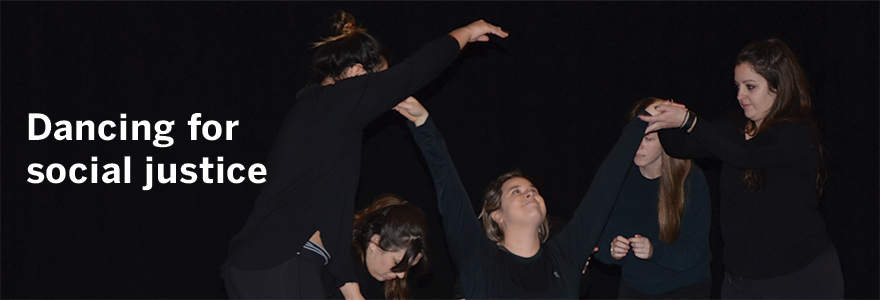
Teacher candidates perform a dance and drama routine at the Faculty of Education.

Teacher candidates perform a dance and drama routine at the Faculty of Education.
Dance and drama are more than performing arts. Rather, these disciplines teach important life-skills such as communication, collaboration, problem-solving, perspective taking, and critical thinking that can support students at all levels of education with their academic achievement and success.
For the past four years, a mandatory dance and drama course has been offered at the Faculty. One component of the course invites teacher candidates to explore social justice themes and concepts, through dance and drama, while making connections to the Ontario elementary curriculum.
“The arts are really about exploring our world,” said course instructor, Traci Scheepstra, PhD. “It’s about knowing ourselves, learning about others and learning about the world around us.”
The arts support learning that is process-oriented, not just product driven, added Scheepstra. This means a performance doesn’t have to be the goal when creating art. However, working through ideas to produce a final product can be a valuable experience for students. Performance opportunities invite students to share what they have learned about a particular topic through a creative means of expression. Students also develop life skills when working with others in the art making process.
Teacher candidate Michelle Suave appreciated exploring the creative process. As a trained dance teacher, she said this process doesn’t occur when teaching in a dance studio.
“It’s a different curriculum,” said Suave. “When you’re working in a studio it’s very traditional as you teach from a book.”
In the course, teacher candidates learn that there’s a multi-step approach to working through an idea from inception to completion. First, students brainstorm an idea that focuses on equity and inclusion. Then, they break down that theme into issues. Finally, they connect their selected issue to the curriculum and how it can be expressed through dance and drama, said Scheepstra.
At the end of the course, teacher candidates perform in front of their classmates.
The dance and drama talent varies in the class. Some teacher candidates have formal dance and drama training while others don’t have any. Regardless of their skill level, they leave the class with confidence.
“If I can do it then I can teach my students to feel confident even if they feel they’re not capable of doing something,” said teacher candidate Robyn Nicholls.
Teacher candidates also learn that there is much more to the arts than art making, said Scheepstra. Dance and drama supports mental health and wellness, the building of safe classroom communities, cross-curricular teaching – such as dance and math as well as dance and social studies – and embodied experiences where students learn by “doing.”
The arts provide unique learning opportunities for students when used in school settings.
“It’s what makes meaning of our lives and what helps us to communicate, feel and discern,” said Scheepstra.
For students like Nicholls, the dance and drama course has increased her confidence in how to incorporate the arts into her lesson planning.
“It gives us a foundation to build on because a lot of kids don’t know how to incorporate the arts or may not see the value in it,” she said. “I feel most of us leaving this class will feel more comfortable.”